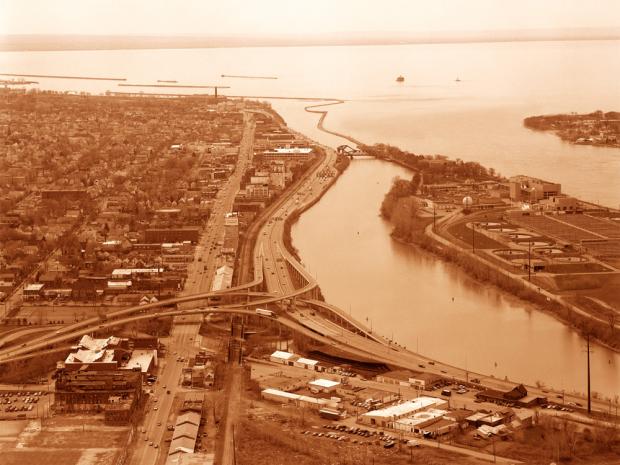Resemblance and Representation: Frank O'Connor at CEPA
Some of Frank O’Connor’s photos currently on display at CEPA seem plain and straightforward enough. Some often quite spectacular aerial views of urban built environment, and some nature images. Others are harder to figure. One looks a little like stir-fry. Another like rice noodles in close-up. But it’s the apparently plain and straightforward ones you have to watch out for.
Watch out for tricks. One of the more spectacular photos—an aerial view of a huge stretch of the West Side, looking toward downtown—Niagara Street, the canal, Unity Island, toward the Erie Basin Marina and Coast Guard Station lighthouse in the distance—can clue you in to the kind of trickery. A wonderful photo, grand-scale, sepia-toned. But then as you gaze at it—admire it—gradually you perceive—begin to perceive—something’s amiss. Not quite right. Where’s the Peace Bridge?
You think, it must be just out of frame. But no, it should be right in the middle of the picture, south of Unity Island, north of Erie Basin Marina. Then you think, it must be an historical photo, from before the bridge was built, in the late 1920s. The sepia tonality accords with this idea. But no again. There’s the I-190 expressway. That wasn’t there in the 1920s. Using Photoshop or whatever manipulation software, he’s removed the Peace Bridge.
The most obvious cityscape manipulation photo is of downtown San Francisco. A kind of Photoshop collage of the huge Transamerica pyramid building shoe-horned into a much too small for it urban intersection, a variety of other buildings shouldering up against the monster.
So then what about the downtown Buffalo—not the West Side photo—aerial view? Harder to tell what might be rearranged, given the unfamiliar aerial vantage point and photo effect collapsed perspective. A puzzle piece just for Buffalonians, it looks like. How well do you know your city?
An aerial view of the Central Terminal Building shows the building and grounds in remarkably spiffy condition. Not a single broken window. Even the train passenger docks behind the building all trim and tidy. You think, it must be an historical photo. Except no trains.
A foggy abstraction work is overlaid with Morse Code symbology that if you work out the message says, “Art lives only within its reading as art.” Which seems to be saying—on the Photoshop versus no Photoshop question about photography as art—Photoshop mandatory, for photography to be called art. Updating an earlier question about whether photography was art at all, versus just mechanical process. (All ultimately nonsense questions, but fun to kick around on the playing fields of aesthetic theory. Photography’s first acceptance into the temple and sacred precincts of art was via manipulation, by the Photopictorialists.)
Some multiple segments works depict ice floes, variously glistening white and end-of-season muddy brown, and manipulated into a kind of whitish plasma. The rice noodles example.
Among some possibly—but just possibly—unmanipulated photos is a series documenting the same artist’s Serpent of Dreams sculptural creation line of interlaced logs and branches a few years ago at Artpark, on dates from mid-summer to early winter.
Two spectacular cityscape photos present similar views of expressway on and off ramps downtown. One from winter 2014—the roadways all icy white and hazardous-looking—and one from December 2015—wet roads, but not a snowflake or ice crystal in sight. Documenting the official incontrovertible start of global warming in Western New York apparently.
Also included, some whole-cloth computer construct photos—these are not my favorites—with the artist’s name in Irish in marquee block letters, Ciarán O Conchobhair.
Other photos from the artist’s travels. One from Dublin—a public sculptural depiction of pre-Christian Irish legends—and one from Stonehenge. A disquieting thought. Has he rearranged the megaliths? Or maybe added or subtracted a few? You wouldn’t put it past him.
The Frank O’Connor exhibit continues until March 5.

